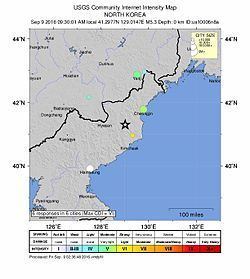Test type Underground Date 9 September 2016 Number of tests 1 | Previous test January 2016 test | |
 | ||
Period 09:00:01, 9 September 2016 (2016-09-09T09:00:01) UTC+08:30 (00:30:01 UTC) Max. yield Exact yield was not announced by North Korea (Democratic People's Republic of Korea)Estimated at about 10 kilotons of TNT (42 TJ) (South Korea estimation)20–30 kilotons of TNT (84–126 TJ)(Jeffrey Lewis of the California-based Middlebury Institute of International Studies)25 kilotons of TNT (100 TJ)(Federal Institute for Geosciences and Natural Resources)11.9–23.7 kilotons of TNT (50–99 TJ)(University of Science and Technology of China) Location | ||
The government of North Korea conducted a nuclear detonation on 9 September 2016, the fifth since 2006, at the Punggye-ri Nuclear Test Site, approximately 50 kilometres (30 miles) northwest of Kilju City in Kilju County.
Contents
Background
North Korea's previous nuclear test was conducted 8 months earlier in January 2016 and drew sharp international condemnations. Despite calls from China and Russia to return to the six-party talks, North Korea maintained its nuclear and missile ambitions:
The nuclear test was conducted on 9 September 2016, which is the 68th anniversary of the founding of North Korea.
Yield estimates
According to South Korean and Japanese estimates, the nuclear yield was equivalent to about 10 kilotons of TNT (10 kt), generating about a 5.3 magnitude seismic shock. This would make the explosion the largest North Korean nuclear test.
Jeffrey Lewis of the California-based Middlebury Institute of International Studies told Reuters that the blast is estimated to be at least 20 to 30 kt. The article has since been republished by some international media outlets. Such a yield would make the blast more powerful than that of the Little Boy atomic bomb dropped on Hiroshima in 1945.
The German Federal Institute for Geosciences and Natural Resources has initially estimated the yield as 25 kt.
The Japanese military dispatched two Kawasaki T-4 aircraft fitted with special containers to measure airborne radioactivity.
On 10 September 2016, the academics from University of Science and Technology of China have released their findings based on seismic results and concluded that the Nuclear Test Location is at 41°17'54.60N, 129°4'40.80E on 00:30:01.366 UTC which is only a few hundred meters apart from the previous 3 tests (2009, 2013 and January 2016) with the estimated yield at 17.8 ±5.9 kt (An estimated yield between 11.9 kT to 23.7kT).
North Korean response
The North Korea state media did not immediately announce the test, instead showing archive footage of the country's founder, Kim Il-sung, as well as of his son and former leader Kim Jong-il.
By 13:50 Pyongyang Standard Time, state media KCNA confirmed that this was the fifth nuclear test and that the "warhead can be mounted to a missile".
Speculation for further testing
The United States officials and its scientific experts believed that North Korea has prepared for its sixth nuclear test, which could be ready by early October 2016. If the speculation is true, then the supposedly sixth nuclear test would coincide with its 10th anniversary since the North's first nuclear test as well as the month where People's Republic of China is formed.
International response
The test, conducted in defiance of the international community, prompted wide international condemnation.
The UN Security Council condemned the test and said it would formulate a new resolution, with the US, Britain and France pressing for new sanctions. US Secretary of Defense Ash Carter stated in a press conference that "China has and shares an important responsibility for this development and has an important responsibility to reverse it". China has not confirmed its support for tougher sanctions. University of Tokyo professor Tadashi Kimiya told Reuters: "Sanctions have already been imposed on almost everything possible, so the policy is at an impasse. In reality, the means by which the United States, South Korea and Japan can put pressure on North Korea have reached their limits".
U.S. President Barack Obama, South Korean president Park Geun-hye and Japanese prime minister Shinzō Abe agreed to jointly "take additional significant steps, including new sanctions, to demonstrate to North Korea that there are consequences to its unlawful and dangerous actions". The U.S., South Korea and Japan immediately called an emergency closed-door meeting of the United Nations Security Council; in a statement issued on September 9, the Council strongly condemning the test and said that it would take "further significant measures" in response, as it had pledged to do in a previous resolution if a violation occurred again. The statement said that non-military actions such as sanctions would be taken under Article 41 of the United Nations Charter.
